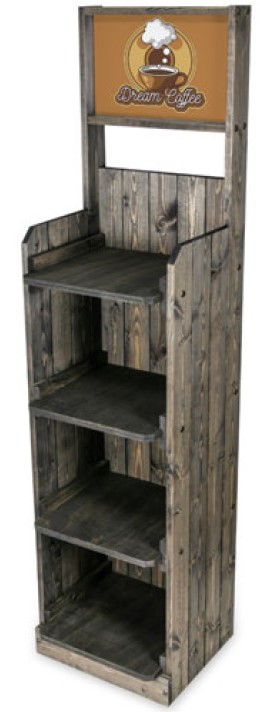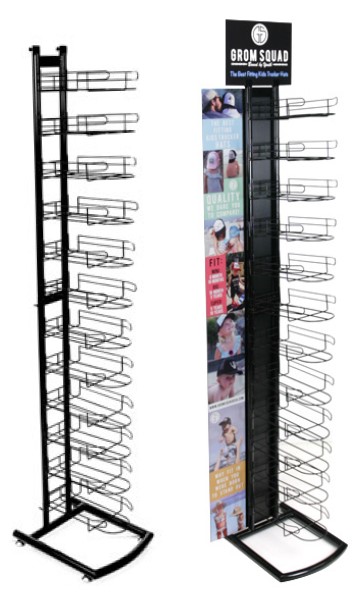As planning horizons in the retail industry continue to shrink while forecasting becomes increasingly uncertain and less reliable, brands and retailers alike face tighter lead times for implementing new retail programs. Choosing to go with a stock retail display can be an excellent strategy for dealing with shorter lead times. However, selecting the right stock display requires careful consideration of 10 important factors. In Part I of this series, we will share the first 5 factors which we believe should be a part of any stock display purchasing evaluation process.
- Product Fit– Make sure your product fits the stock display. This seems obvious, but it is important that you understand the details of the measurements listed by the manufacturer. For example, we offer the wood shelf display shown below as a stock item and list the overall dimensions as well as the shelf dimensions. But to ensure your product fits, find out if the listed shelf dimensions are inside dimensions or outside dimensions as well as the vertical distance between shelves.
2. Capacity– There are two components of capacity, both of which are important to understand. First, there is the overall carrying capacity of the retail merchandising display. That is, will the display hold enough of your product to support your retail program and have the economics make sense. Second, there is the load capacity which is the amount of weight the display can hold. As an example, we offer a very economical stock wire shelf display. It’s great for lightweight items, but if you plan on loading it with 50 lbs. per shelf, it’s not the right display.
3. Foot Print– The foot print of the display is always important since a standard metric among retailers is sales per square foot. It’s an easy calculation for any brand and well worth the exercise. In general, selecting displays with smaller footprints will improve your chances of getting placement in retail stores. Our stock footwear display is a good example since it features a relatively small footprint.
4. Customization Options– Being able to customize a stock retail display can be important to building your brand. You may be interested in another blog we wrote on this topic:
How Stock Displays Can Help Build Your Brand at Retail. There are lots of ways to customize a stock display, but the easiest way is to add custom graphics. A simple example shown below is one of our stock headwear displays to which we added a flag and header sign for Grom Squad.
For more ideas on customizing stock displays, you might want to check out two of our other blogs:
POP Display Ideas for Customizing Stock Floor Displays
Creating a Unified Store Environment by Customizing Stock POP Displays
5. Configurability– Selecting a stock display that is configurable is a great way to future-proof your display investment. Being able to configure your display with different retail merchandising components will give you the flexibility to change your product mix and accommodate new products without having to invest in a new display. Our stock 4-WAY apparel fixture is a good example. It comes with a base and slotted frame. It can be configured with straightouts, waterfalls, jetrails, shelves, cap pockets, hooks, and a header sign.
For additional examples of configurable stock displays, you might want to check out our post entitled Stock POP Displays that Offer Configurability and Versatility.
Be sure to look for Part II of this series in which we will share 5 additional factors to consider before you buy a stock retail display.
Jim Hollen is the owner and President of RICH LTD. (www.richltd.com), a 35+ year-old California-based point-of-purchase display, retail store fixture, and merchandising solutions firm which has been named among the Top 50 U.S. POP display companies for 9 consecutive years. A former management consultant with McKinsey & Co. and graduate of Stanford Business School, Jim Hollen has served more than 3000 brands and retailers over more than 20 years and has authored nearly 500 blogs and e-Books on a wide range of topics related to POP displays, store fixtures, and retail merchandising.
Jim has been to China more than 50 times and has worked directly with more than 30 factories in Asia across a broad range of material categories, including metal, wood, acrylic, injection molded and vacuum formed plastic, corrugated, glass, LED lighting, digital media player, and more. Jim Hollen also oversees RICH LTD.’s domestic manufacturing operation and has experience manufacturing, sourcing, and importing from numerous Asian countries as well as Vietnam and Mexico.
His experience working with brands and retailers spans more than 25 industries such as food and beverage, apparel, consumer electronics, cosmetics/beauty, sporting goods, automotive, pet, gifts and souvenirs, toys, wine and spirits, home improvement, jewelry, eyewear, footwear, consumer products, mass market retail, specialty retail, convenience stores, and numerous other product/retailer categories.






